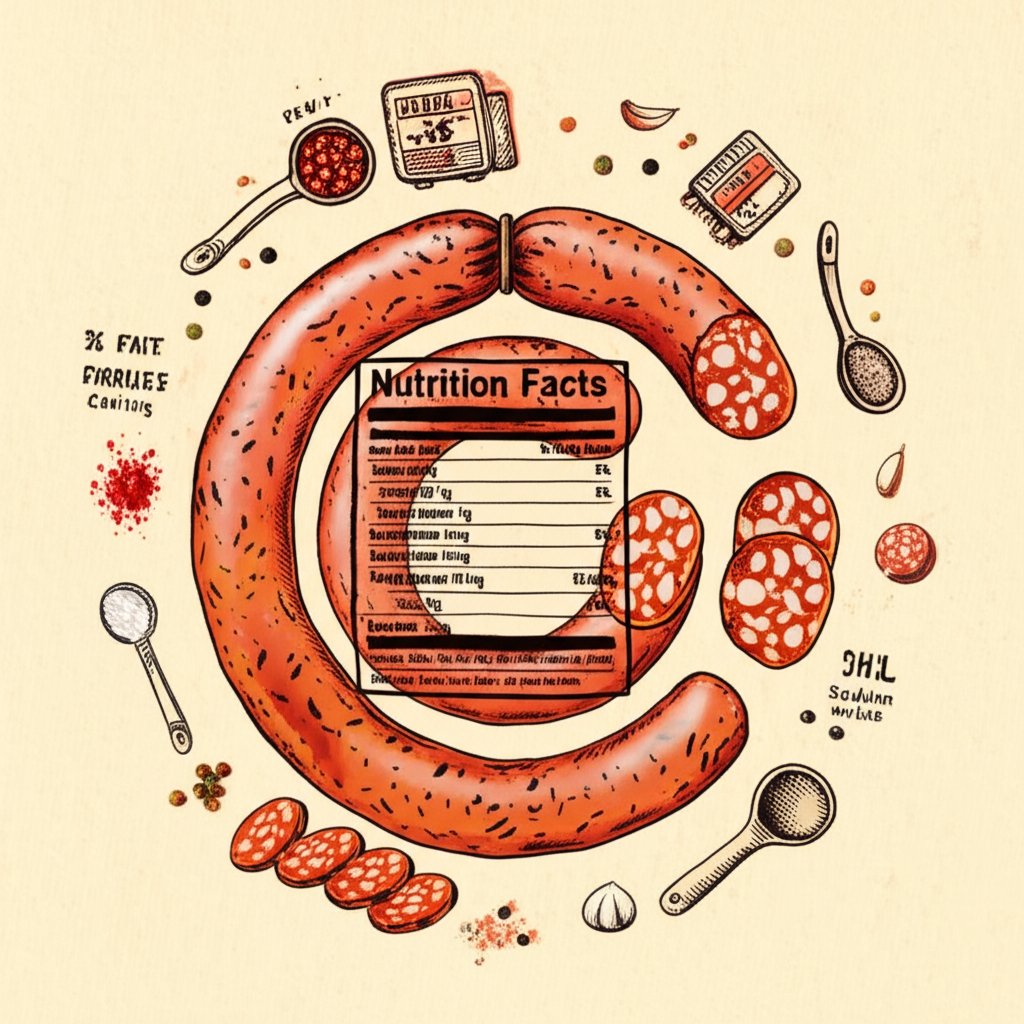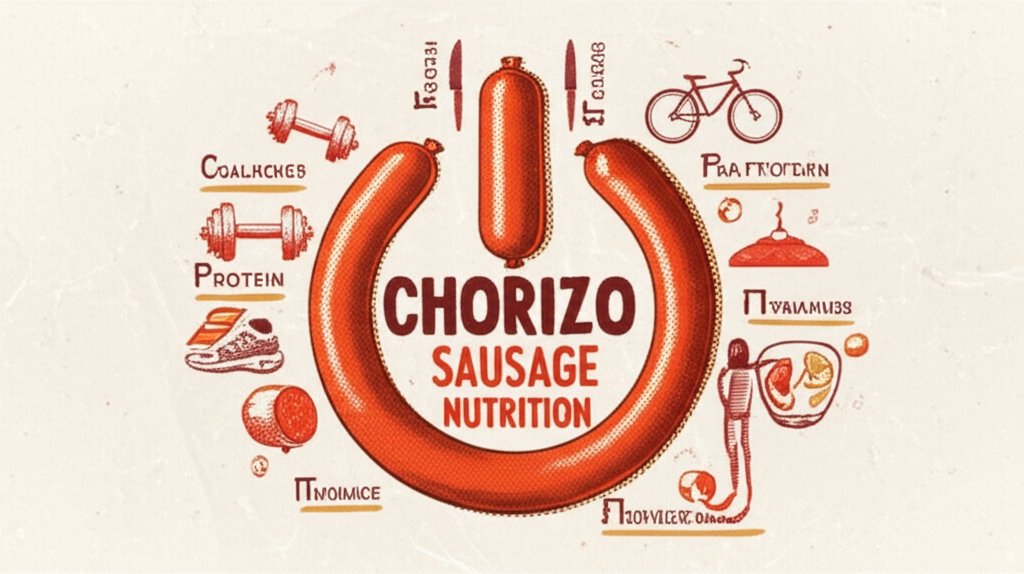Ever wondered exactly what you’re getting when you bite into that spicy, smoky chorizo? Beyond the delicious flavor, understanding the chorizo nutrition facts is key to making informed choices about how it fits into a balanced diet. From calories and fat content to sodium and protein, let’s unpack what’s really inside this flavorful sausage.
At a glance:
- Discover the typical calorie, fat, protein, and sodium content of different types of chorizo.
- Learn how chorizo’s nutritional profile compares to other sausages and protein sources.
- Understand the potential health benefits and drawbacks of including chorizo in your diet.
- Get practical tips for enjoying chorizo in moderation and making healthier preparation choices.
- Address common misconceptions about chorizo’s nutritional value and impact on health.
Decoding the Chorizo Nutrition Label: What to Look For
Navigating the world of chorizo nutrition can feel overwhelming. It’s crucial to understand what exactly you are putting in your body and what the possible side effects are. The nutrition in chorizo can vary quite a bit based on a few factors like the type of meat used, the curing process, and the addition of other ingredients. Here’s a breakdown of the key nutrients to keep an eye on:
- Calories: The amount of energy the chorizo provides – high calorie means more energy, but also needs to be burned off.
- Fat: A major component, greatly impacting flavor and satiety.
- Saturated Fat: Limiting this type of fat is important for heart health.
- Sodium: Chorizo can be high in sodium due to the curing process, so watch out for that.
- Protein: Contributing to muscle building and overall satiety.
- Carbohydrates: Usually present in low amounts, varying with ingredients.
- Vitamins & Minerals: Contains iron and other nutrients, though not in significant amounts.
Example:
A 1-ounce serving of raw Mexican chorizo might contain approximately: - 130 calories
- 11g total fat (4g saturated fat)
- 400mg sodium
- 7g protein
- 1g carbohydrates
Always check the label, as these values can vary. Spanish chorizo generally has different values than Mexican Chorizo.
Chorizo Types and Their Nutritional Profiles: A Quick Comparison
The type of chorizo significantly influences its nutritional content. Here’s a brief comparison:
| Type of Chorizo | Key Characteristics | Typical Calorie Range (per 1oz) | Key Nutritional Notes |
|---|---|---|---|
| Mexican | Raw, ground pork, heavily spiced | 120-150 | Generally higher in fat due to the type of pork used. The sodium content can vary significantly depending on the recipe. |
| Spanish | Cured, smoked, paprika-based | 130-160 | Curing process leads to higher sodium levels. Paprika contributes some Vitamin A. Varies from sweet (dulce) to spicy (picante). |
| Argentinian | Fresh, less spicy than Mexican chorizo | 80-120 | Typically made with leaner cuts of pork, resulting in lower fat content. Less sodium compared to cured varieties. Usually grilled before consumption. |
| Vegan Chorizo | Plant-based (soy, chickpeas, etc.) | 70-100 | Generally lower in fat and calories than meat-based chorizo. Sodium content can still be high depending on the brand. Check the label for added sugars and artificial ingredients. May be lower in protein compared to pork-based chorizo, depending on the ingredients used. Offers a cholesterol-free alternative. |
| Understanding these differences empowers you to choose the right chorizo for your dietary needs and preferences. |
The Good, the Bad, and the Delicious: Weighing the Health Implications
Chorizo, in moderation, can be part of a flavorful diet. However, it’s essential to be aware of the potential health considerations:
Potential Benefits:
- Protein Source: Chorizo delivers a good amount of protein. As you may know, a dish like Chicken Tikka Masala also has a good source of protein. You can learn more about it here: Chicken Tikka Masala Nutrition Guide.
- Iron Content: Provides iron, crucial for oxygen transport.
- Flavor Enhancer: Adds spice and depth to dishes, potentially reducing the need for excessive salt or unhealthy fats from other sources.
Potential Drawbacks: - High in Saturated Fat: Can contribute to elevated cholesterol levels if consumed in excess.
- High Sodium Content: May increase blood pressure, particularly for sodium-sensitive individuals.
- Calorie Density: Can contribute to weight gain if portion sizes are not controlled.
- Processed Meat Concerns: Some studies link high processed meat intake to increased risk of certain health issues; moderation is key.
Practical Tip:
Balance chorizo’s richness by pairing it with fiber-rich vegetables and whole grains. For example, add Spanish chorizo to paella with brown rice and plenty of vegetables, or crumble Mexican chorizo into a black bean and corn salad.
Making Smart Choices: Tips for Healthier Chorizo Consumption
Here are a few simple ways you can make better choices when consuming chorizo:
- Choose Leaner Options: Opt for chorizo made with leaner cuts of pork or even plant-based versions to reduce fat content.
- Control Portion Sizes: Stick to smaller servings (1-2 ounces) to manage calorie and sodium intake.
- Drain Excess Fat: After cooking Mexican chorizo, drain off any excess fat to reduce the overall fat content in your meal.
- Pair with Healthy Ingredients: Combine chorizo with vegetables, whole grains, and legumes to create balanced meals.
- Limit Frequency: Enjoy chorizo as an occasional treat rather than a daily staple.
- Read Labels Carefully: Compare nutrition labels of different brands to choose options lower in sodium and saturated fat.
Case Snippet:
Maria, a food enthusiast, loves adding chorizo to her breakfast tacos. To make it healthier, she now mixes a smaller amount of chorizo with scrambled eggs, black beans, and plenty of vegetables on whole wheat tortillas. This adds flavor while keeping the meal balanced and nutritious.
Chorizo in Action: Recipe Tweaks for a Healthier Dish
Let’s consider a popular dish: Chorizo and Potato Tacos. Here’s how to make it healthier:
Traditional Recipe (Less Healthy):
- Large amount of Mexican chorizo fried in oil.
- White potatoes, also fried.
- Served on white flour tortillas.
- Topped with full-fat sour cream and cheese.
Healthier Version: - Use half the amount of chorizo and opt for leaner chorizo if available.
- Boil the potatoes until tender, then lightly sauté with a touch of olive oil and spices.
- Use corn tortillas or whole wheat tortillas.
- Top with plain Greek yogurt (a great sour cream substitute) and a sprinkle of low-fat cheese.
By making these simple substitutions, you can enjoy the flavor of chorizo without the excess fat and calories.
Featured Snippet-Friendly Q&A: Common Questions About Chorizo
Q: Is chorizo high in sodium?
A: Yes, chorizo is generally high in sodium due to the curing process and added seasonings. Check the nutrition label and choose lower-sodium options when available.
Q: Is chorizo a good source of protein?
A: Yes, chorizo provides a good amount of protein, essential for muscle building and overall satiety. However, consider the high fat and sodium content as well.
Q: Can I eat chorizo if I’m on a low-carb diet?
A: Yes, chorizo can fit into a low-carb diet, as it is primarily fat and protein with minimal carbohydrates. Be mindful of portion sizes due to the high calorie and fat content.
Q: Is vegan chorizo healthier than pork chorizo?
A: Vegan chorizo is often lower in fat and cholesterol than pork chorizo. However, it can still be high in sodium and may contain added sugars or artificial ingredients. Always check the nutrition label.
Beyond the Basics: More Advanced Chorizo Considerations
Thinking beyond the basic nutritional stats, here are some additional pieces to consider:
- Nitrates and Nitrites: These preservatives are often added to cured meats like chorizo. Some people are sensitive to these compounds.
- Source of Meat: Consider the source of the pork used in your chorizo. Pork sourced from responsible farms typically have better overall health characteristics.
- Spice Levels: The spice blend in chorizo can vary widely. Be aware of your tolerance for spice, especially if you have digestive sensitivities.
- Added Sugars: Some manufacturers add sugar to their chorizo products. A good rule of thumb is that sugar should be less than 5 grams per serving.
Actionable Close: Your Chorizo Playbook
Here’s a quick roadmap to enjoy chorizo responsibly:
- Assess: What types of chorizo do you typically consume?
- Compare: Check nutrition labels and compare sodium, fat, and ingredients with other chorizo options.
- Adapt: Modify your recipes to include leaner versions, smaller portions, and healthier complements.
- Monitor: Pay attention to how your body responds to chorizo consumption (blood pressure, cholesterol, digestion) and adjust accordingly.
- Enjoy: Savor chorizo as a flavorful addition to a balanced and varied diet.

- Plastic Bento Boxes Face Scrutiny Over Sustainability Impacts - December 11, 2025
- Bento Tray Revolutionizes Organized Meal Transport and Presentation - December 10, 2025
- Meal Plans for Busy Schedules That Make Healthy Eating Easy - December 10, 2025










